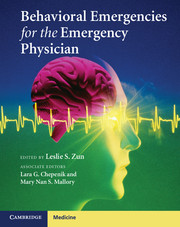Book contents
- Behavioral Emergencies for the Emergency Physician
- Behavioral Emergencies for the Emergency Physician
- Copyright page
- Contents
- Contributors
- Preface
- Section 1. General considerations for psychiatric care in the emergency department
- Section 2. Evaluation of the psychiatric patient
- Section 3. Psychiatric illnesses
- Chapter 8 The patient withdepression in the emergency department
- Chapter 9 Assessment of the suicidal patient in the emergency department
- Chapter 10 The patient with somatoform disorders in the emergency department
- Chapter 11 The patient with anxiety disorders in the emergency department
- Chapter 12 The patient with post-traumatic stress disorder in the emergency department
- Chapter 13 The patient with psychosis in the emergency department
- Chapter 14 Personality disorders in the acute setting
- Chapter 15 The patient with factitious disorders or malingering in the emergency department
- Chapter 16 The patient with delirium and dementia in the emergency department
- Chapter 17 The patient with excited delirium in the emergency department
- Chapter 18 Medical illness in psychiatric patients in the emergency department
- Chapter 19 Acute care ofeating disorders
- Chapter 20 Management of the emergency department patient with co-occurringsubstance abuse disorder
- Section 4. Treatment of the psychiatric patient
- Section 5. Special populations
- Section 6. Administration of psychiatric care
- Index
Chapter 15 - The patient with factitious disorders or malingering in the emergency department
from Section 3. - Psychiatric illnesses
Published online by Cambridge University Press: 05 April 2013
- Behavioral Emergencies for the Emergency Physician
- Behavioral Emergencies for the Emergency Physician
- Copyright page
- Contents
- Contributors
- Preface
- Section 1. General considerations for psychiatric care in the emergency department
- Section 2. Evaluation of the psychiatric patient
- Section 3. Psychiatric illnesses
- Chapter 8 The patient withdepression in the emergency department
- Chapter 9 Assessment of the suicidal patient in the emergency department
- Chapter 10 The patient with somatoform disorders in the emergency department
- Chapter 11 The patient with anxiety disorders in the emergency department
- Chapter 12 The patient with post-traumatic stress disorder in the emergency department
- Chapter 13 The patient with psychosis in the emergency department
- Chapter 14 Personality disorders in the acute setting
- Chapter 15 The patient with factitious disorders or malingering in the emergency department
- Chapter 16 The patient with delirium and dementia in the emergency department
- Chapter 17 The patient with excited delirium in the emergency department
- Chapter 18 Medical illness in psychiatric patients in the emergency department
- Chapter 19 Acute care ofeating disorders
- Chapter 20 Management of the emergency department patient with co-occurringsubstance abuse disorder
- Section 4. Treatment of the psychiatric patient
- Section 5. Special populations
- Section 6. Administration of psychiatric care
- Index
Summary
- Type
- Chapter
- Information
- Behavioral Emergencies for the Emergency Physician , pp. 113 - 116Publisher: Cambridge University PressPrint publication year: 2013



